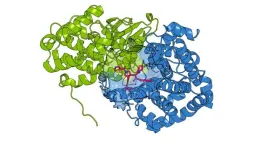(Press-News.org) Outdoor air pollution from power plants, fires and cars continues to degrade human, animal and environmental health around the globe. New research shows that even pollution levels that are below government air-quality standards are associated with differences in children’s brains.
A University of California, Davis, research team systematically analyzed 40 empirical studies, the majority of which had found that outdoor air pollution is associated with differences in children’s brains. These differences include volumes of white matter, which is associated with cognitive function, connections throughout the brain and even early markers for Alzheimer’s.
The study, “Clearing the Air: A systematic review of studies on air pollution and childhood brain outcomes to mobilize policy change,” was published this month in Developmental Cognitive Neuroscience.
“We're seeing differences in brain outcomes between children with higher levels of pollution exposure versus lower levels of pollution exposure,” said Camelia Hostinar, an associate professor of psychology and the study’s corresponding author.
Children and teens are especially vulnerable to air pollution because their brains and bodies are still developing. They tend to spend more time outdoors, and their bodies absorb more contaminants relative to their bodyweight than adults, researchers said.
Outdoor air pollution and brain development
This study surveyed 40 published, peer-reviewed studies that all included measures of outdoor air pollution and brain outcomes for children at various ages, from newborns up to 18-year-old adults. The majority of studies came from the United States, Mexico and Europe, with one each from Asia and Australia.
The studies ranged in how they measured brain differences. Some used advanced scanning methods like magnetic resonance imaging, or MRI. Others tested changes in chemical compounds that aid in brain function and health. Some studies looked for tumors in the brain or central nervous system.
Studies from Mexico City that compared children from high- and low-pollution areas found significant differences in brain structure.
Each study included measures of air pollution linked to the child’s address or neighborhood, which showed that the children’s brain differences were observed in places with high levels of air pollution as well as places that met local air pollution standards.
“A lot of these studies include children in places with air pollutant levels that are well below limits set by U.S. or European regulations,” said Anna Parenteau, a Ph.D. student in psychology at UC Davis and the study’s co-first author.
Outdoor air pollution
Sources of outdoor air pollution include coal-fired plants, wildfires and many other sources near where people live. This systematic review is unique because most others have focused on how air pollution affects adults or animals, researchers said.
“We can't necessarily apply findings from adults and assume that it's going to be the same for children,” said Johnna Swartz, an associate professor of human ecology and co-author on the study. “We also have to look more at different developmental windows because that might be really important in terms of how air pollution might impact these brain outcomes.”
To establish a causal link between outdoor air pollution and differences in the brain, the research team looked to experimental research on animals. That research showed that pollution does lead to many of the same outcomes identified by the studies in this review, including markers for Alzheimer’s disease.
“A lot of researchers working on brain development, whether it's autism, Alzheimer's or something else, really discounted for a long time the environmental factors,” said Anthony Wexler, a professor at UC Davis and director of its Air Quality Research Center. “They argued that it’s genetic or some other factor other than exposure to air pollution. That's changed a lot recently because of all this research literature.”
Reducing harm
This systematic review proposed steps for both parents and policymakers to protect their children from outdoor air pollution by, for example, adding air filters to homes and schools near freeways.
“We listed air purifiers as one of the policy recommendations, and that is something that could be subsidized or provided in schools and other places where children spend a lot of time,” said Hostinar. “These can be quite effective.”
Researchers can also incorporate measures of air pollution into studies related to brain health or other health outcomes.
“Anybody collecting data from human participants on brain outcomes or cardiovascular outcomes or anything else could easily add questions to assess air pollution exposure, such as obtaining their addresses,” said Sally Hang, a Ph.D. student in psychology and the study’s first co-author.
END
Research in 4 continents links outdoor air pollution to differences in children’s brains
2024-10-01
ELSE PRESS RELEASES FROM THIS DATE:
UTA physicists explore possibility of life beyond Earth
2024-10-01
Are there planets beyond Earth where humans can live? The answer is maybe, according to a new study from University of Texas at Arlington physicists examining F-type star systems.
Stars fall into seven lettered categories according to their surface temperature. They also differ in other factors including mass, luminosity, and radius. F-types are in the middle of the scale, hotter and more massive than our sun. F-type stars are yellowish white in color and have surface temperatures of more than 10,000 degrees.
A habitable zone (HZ) is the distance from a star at which water could exist on orbiting planets’ surfaces. In the research led by doctoral student Shaan Patel ...
Seeing double: Designing drugs that target “twin” cancer proteins
2024-10-01
LA JOLLA, CA—Some proteins in the human body are easy to block with a drug; they have an obvious spot in their structure where a drug can fit, like a key in a lock. But other proteins are more difficult to target, with no clear drug-binding sites.
To design a drug that blocks a cancer-related protein, Scripps Research scientists took a hint from the protein’s paralog, or “twin.” Using innovative chemical biology methods, the scientists pinpointed a druggable site on the paralog, and then used that knowledge to characterize drugs that bound to a similar—but more difficult to detect—spot on its twin. Ultimately, they found drugs ...
Fierce names Insilico Medicine as one of its Fierce 50 Honorees of 2024
2024-10-01
Cambridge, MA, Sept. 26, 2024 –Insilico Medicine, a clinical-stage generative AI-driven drug discovery company, announced today that Fierce Life Sciences and Fierce Healthcare have named Insilico Medicine as one of 2024’s Fierce 50 honorees. The Fierce 50 showcases 50 individuals and companies driving advancements in medicine, fostering innovation and shaping the future of biopharma and healthcare.
“The annual Fierce 50 special report highlights individuals and companies that are driving progress in the pharmaceutical, healthcare and biotechnology industries,” said Ayla Ellison, Editor-in-Chief of Fierce Life Sciences and Healthcare. “These 50 outstanding ...
Cleveland Clinic researchers build first large-scale atlas of how immune cells react to mutations during cancer immunotherapy
2024-10-01
A Cleveland Clinic-led research collaboration between Timothy Chan, MD, PhD, Chair of Cleveland Clinic’s Global Center for Immunotherapy, and Bristol Myers Squibb has published the most comprehensive overview to date of how the immune system reshapes tumor architecture in response to immune checkpoint therapy.
The eight-year study, published in Nature Medicine, outlines how cancer immunotherapy induces tumor recognition through neoantigens to reshape the tumor ecosystem. Neoantigens are small peptides produced when cancer cells mutate and are a primary marker for the immune system to recognize cancer cells as different ...
Pioneering quantum computer research continues in Baden-Württemberg
2024-10-01
Utilizing the potential of quantum computers and achieving a real advantage for practical applications — this goal is being pursued worldwide. In Baden-Württemberg, the Competence Center Quantum Computing Baden-Württemberg (KQCBW) has dedicated itself to this goal over the past four years. Great progress has been made in various areas of quantum computing in successful joint projects. The success of the KQCBW is now to be continued and the unique quantum computing ecosystem in the state further expanded.
The KQCBW will be continued in a ten-month transfer project ...
Discovery of orbital angular momentum monopoles enables orbital electronics with chiral materials
2024-10-01
In traditional electronics, information is transferred using the charge of electrons. However, future technologies may rely on a different property of electrons—their intrinsic angular momentum. Historically, the focus has been on electron spin, a form of build-in angular momentum that creates a magnetic moment, as the leading candidate for next-generation devices. Now, researchers are exploring the potential of orbitronics, a field that utilizes the angular momentum of electrons generated as they orbit the atomic nucleus. Orbitronics holds great promise ...
New mouse models offer valuable window into COVID-19 infection
2024-10-01
LA JOLLA, CA—Scientists at La Jolla Institute for Immunology (LJI) have developed six lines of humanized mice that can serve as valuable models for studying human cases of COVID-19.
According to their new study in eBioMedicine, these mouse models are important for COVID-19 research because their cells were engineered to include two important human molecules that are involved in SARS-CoV-2 infection of human cells—and these humanized mice were generated on two different immunologic backgrounds. ...
Antibodies in breast milk provide protection against common GI virus
2024-10-01
A study led by researchers at the University of Rochester Medical Center found that breast milk provides protection against rotavirus, a common gastrointestinal disease that causes diarrhea, vomiting and fever in infants. Babies whose mothers had high levels of specific antibodies in their breast milk were able to fend off the infection for a longer period than infants whose mothers had lower levels. The findings are expected to drive future research to improve infant health through optimized breastfeeding practices.
Published in the Journal of Clinical Investigation and funded by the Bill and Melinda Gates Foundation, the study also ...
University of Cincinnati professor named MacArthur fellow
2024-10-01
When the phone rang on a September afternoon, University of Cincinnati's Shailaja Paik, PhD, tired from a full day of meetings and teaching, did not expect to hear news that would leave her “ears numb.”
“I had been named a (MacArthur) fellow, and I wasn’t sure I was hearing correctly, but I tried to keep my cool,” she remembers, chuckling. “I thought, ‘Is this right? I’m going to ask her to repeat herself.’
“I was ecstatic.”
The MacArthur Fellows Program, also ...
Research provides new insights into role of mechanical forces in gene expression
2024-10-01
The genome inside each of our cells is modelled by tension and torsion — due in part to the activity of proteins that compact, loop, wrap and untwist DNA — but scientists know little about how those forces affect the transcription of genes.
“There are a lot of mechanical forces at play all the time that we never consider, we have very little knowledge of, and they’re not talked about in textbooks,” said Laura Finzi, the Dr. Waenard L. Miller, Jr. ’69 and Sheila M. Miller Endowed Chair in Medical Biophysics at Clemson University.
Transcription is the process by which a cell makes an RNA copy of a segment of DNA. One ...





